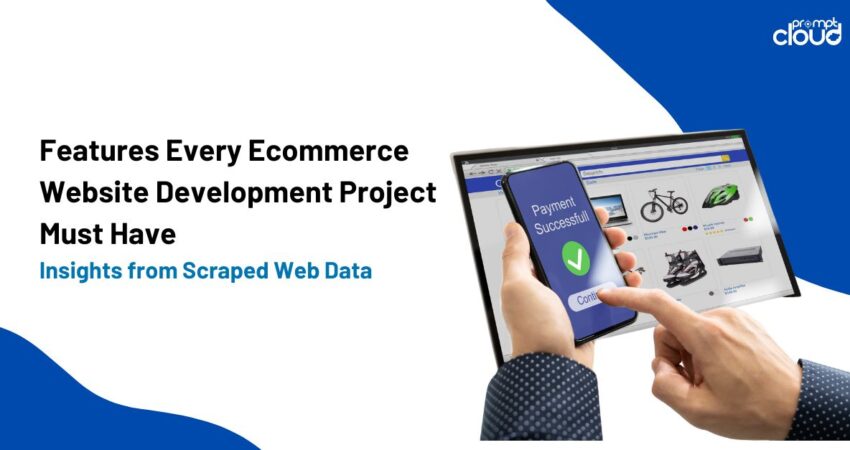
What makes an ecommerce website truly effective? Building a successful ecommerce website goes far beyond just having an online storefront. Customers expect seamless navigation, fast load times, secure transactions, and personalized shopping experiences. To meet these expectations, it’s crucial to incorporate essential features that enhance user experience, build trust, and drive conversions.
Whether you’re launching a new online store or revamping an existing one, understanding the must-have components of ecommerce website development can make or break your success. This article explores the most important elements to include in every ecommerce website project, helping businesses ensure they meet the expectations of online shoppers. Let’s read about them in detail.
User-Friendly Design
A user-friendly design is the foundation of any successful ecommerce site. Visitors should be able to navigate through the site without confusion or frustration. The layout must be clean, intuitive, and organized, with easy access to important pages such as the homepage, product categories, and contact details. Simple, well-labeled categories help users find what they are looking for quickly and efficiently.
A clear call to action is another vital part of the design. Whether it’s “Add to Cart” or “Buy Now,” these buttons should stand out but not overpower the entire design. Additionally, ensuring that the site is visually appealing and easy to use will increase the chances of visitors returning for future purchases. A clutter-free interface with easy navigation options enhances the overall user experience and builds trust with customers.
Mobile Optimization
With more people shopping on their mobile devices, mobile optimization is a must. The website development process should prioritize creating a site that works seamlessly on smartphones and tablets. Mobile-friendly websites ensure users can easily browse products, complete purchases, and access account details on any device.
A responsive design is crucial in making sure that the site adapts to different screen sizes and works flawlessly on both iOS and Android devices. If your site isn’t optimized for mobile use, customers will likely leave in frustration, potentially opting for a competitor’s more mobile-friendly site.
Fast Loading Speed
Website speed plays a significant role in customer experience. A slow website can negatively affect user satisfaction, lead to high bounce rates, and decrease conversions. Shoppers nowadays expect pages to load quickly, and if an ecommerce website takes more than a few seconds to load, they may abandon their cart. Fast loading speeds are essential to providing an enjoyable online shopping experience that meets the expectations of modern consumers.
The speed of an ecommerce website development project depends on various factors, including image sizes, server performance, and the use of external scripts. Optimizing images, compressing files, and simplifying code can significantly improve the site’s speed and enhance the overall browsing experience. Faster loading times contribute to better customer retention and can even improve SEO rankings, leading to more organic traffic.
Secure Payment Gateways
When customers make online purchases, they need to feel confident that their financial information is secure. A secure payment gateway is critical for ensuring safe transactions on your ecommerce website. Without this feature, customers may hesitate to complete a purchase or even avoid your site altogether. Ecommerce businesses must prioritize security to protect both their customers and their reputation.
SSL certificates, encryption technologies, and compliance with data protection standards are essential components of secure payment systems. Providing various payment options like credit cards can also increase conversion rates by catering to different preferences. Offering secure, convenient payment methods builds trust and increases the likelihood of repeat purchases.
Effective Search Functionality
An advanced search feature is vital in guiding users to their desired products quickly and easily. In ecommerce, customers often have a specific item in mind. They don’t want to waste time scrolling through endless pages of products. With an effective search bar, customers can instantly find what they’re looking for, which improves their overall shopping experience and encourages them to make a purchase.
Incorporating filters like size, color, price range, and brand can further refine the search results, making it easier for shoppers to find exactly what they need. A powerful search functionality increases engagement, reduces frustration, and helps boost conversion rates. Moreover, implementing search suggestions or autocomplete features can make it even easier for users to find their desired products in less time.
Seamless Checkout Process
A streamlined, easy-to-understand checkout process is essential in converting interested shoppers into paying customers. Complicated or lengthy checkout procedures are one of the leading causes of abandoned carts. Website development should focus on creating a smooth and quick checkout experience, ensuring customers can finalize their purchases with ease. The simpler the process, the higher the chances of completing the sale.
This includes minimizing the number of steps required to complete the transaction and offering guest checkout options, which allow users to purchase without needing to create an account. Customers should also have the ability to save their information for future purchases, reducing friction on repeat visits. Simplified payment and shipping options, along with clear progress indicators, ensure customers don’t face any obstacles when finalizing their purchases.
Ecommerce website development is a critical investment for businesses looking to reach a global market. Ensuring your site is easy to navigate, mobile-optimized, and fast-loading can significantly improve the user experience and boost conversions. By focusing on these essential features, businesses can increase conversions and build lasting relationships with their audience.




















